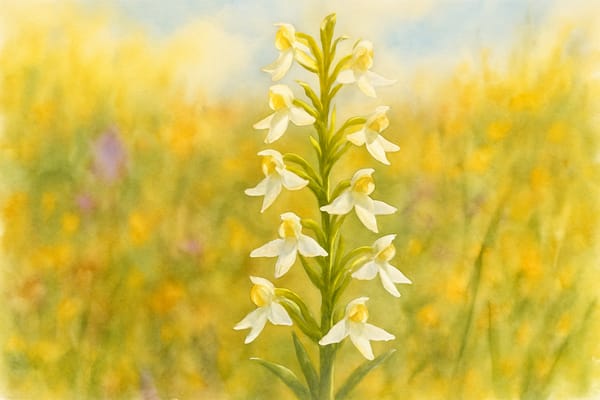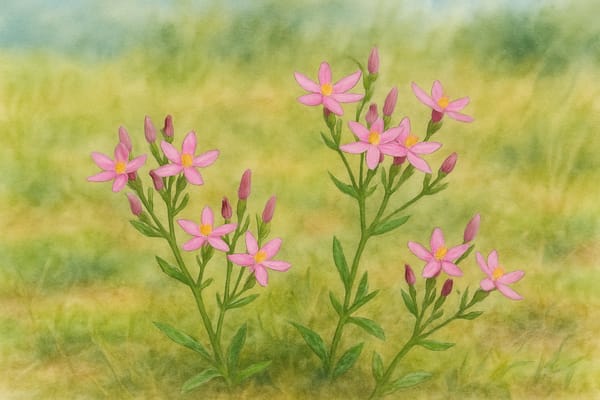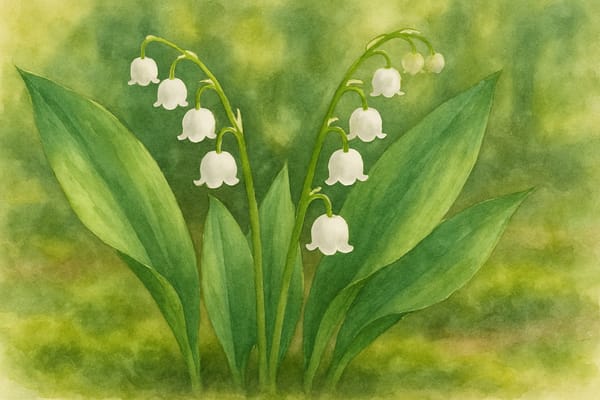A Rare Jewel of Cornwall’s Traditional Meadows
Historical and Cultural Significance
Admired for its graceful, pale-green flowers that resemble tiny butterflies in flight, the Greater Butterfly-orchid has been a quiet symbol of purity, beauty, and rural tradition in Cornwall and the UK.
Symbol of Love and Purity
In folklore, this delicate orchid was associated with love, prophetic dreams, and good fortune. People believed placing its flowers under a pillow could bring visions or luck in love, tying it to centuries of countryside beliefs.
Folk Medicine and Heritage
Historically, it was used in herbal remedies for fevers, headaches, and digestive complaints—though these uses faded over time. Its presence in old hay meadows and woodlands marked it as a plant of traditional landscapes.
Conservation Emblem
Once widespread, this orchid now serves as a flagship species for habitat conservation. Its decline—driven by loss of meadows, overgrazing, and land drainage—mirrors the fate of many British wildflowers, making it a symbol of the urgent need for stewardship.
Artistic Inspiration
Writers, painters, and naturalists have celebrated the orchid for its ethereal beauty, often using it as a motif for the fleeting nature of wild, unspoiled landscapes.
Cornish Context:
Though rare, the Greater Butterfly-orchid still clings on in a few traditional meadows in Cornwall, such as Bodmin Airfield, standing as a living link to the county’s rich, low-impact farming heritage.
Growing the Greater Butterfly-orchid in Coastal Gardens
This orchid needs light, calcareous soils, and a traditional approach—perfect for naturalistic or low-intervention gardens.
| Requirement | Details |
|---|
| Light | Full sun to partial shade; prefers dappled light |
| Soil | Well-drained, calcareous or sandy loam; nutrient-poor |
| Water | Moist, not waterlogged; drought-tolerant once established |
| Salt Tolerance | Moderate; suitable for sheltered coastal sites |
| Hardiness | Hardy in the UK |
Care and Cultivation Tips
- Site Selection:
Choose sunny or lightly shaded areas with nutrient-poor, free-draining soil. Ideal for wildflower borders, calcareous meadows, or open woodland edges. - Soil Preparation:
Avoid fertilizers. Mimic natural, low-nutrient grassland conditions to discourage vigorous competition. - Sowing and Propagation:
Seed germination requires specific soil fungi—natural colonization is rare in garden settings. For best results, source plants from specialist growers. - Watering:
Keep moist until established. After that, minimal watering is needed, especially in coastal climates. - Maintenance:
Practice light grazing or mowing after flowering to keep competition low—this echoes traditional management and supports healthy growth. - Pests and Diseases:
Rarely troubled by pests. Sensitive to soil disturbance, so plant in stable sites.
Coastal Garden Notes
- Adaptation:
Perfect for well-drained, lime-rich coastal soils, especially in sunny, breezy locations. - Wildlife Value:
Its sweet scent attracts night-flying moths and supports biodiversity. - Conservation Awareness:
Growing this orchid highlights the need to protect fragile habitats and maintain traditional land care practices.
Summary
The Greater Butterfly-orchid stands as a delicate reminder of Cornwall’s ancient meadows and traditional land care. With subtle beauty and a powerful conservation message, it thrives in nutrient-poor, sunny soils—rewarding gardeners who cultivate with patience and care.











